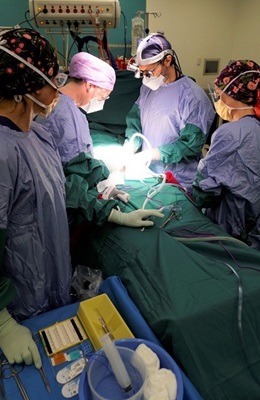2023 | Volume 24 | Issue 6

Climate change has been recognised as the biggest global health threat of the 21st century1, and the healthcare community must advocate for, and participate in, emission reductions and improved sustainability practices. Healthcare has a considerable carbon footprint, contributing to seven per cent of Australia’s carbon dioxide emissions2 with the operating theatre responsible for a significant proportion of this carbon footprint3. Nearly 30 per cent of a hospital’s solid waste is associated with surgery4 including greenhouse gas emissions generated by surgical practice.
RACS advocates for surgeons and hospitals to follow effective waste management and sustainability to reduce the impact of surgery on the environment. This can be done by revisiting and implementing the ‘waste hierarchy’—underpinned by the five Rs—reduce, reuse, recycle, rethink and refuse.
A surgical gown is an example, which is available both in reusable and disposable alternatives. The World Health Organization (WHO)5 confirms that reusable surgical gowns are equivalent to disposable gowns in terms of sterility and infection prevention, water resistant6 , comfort7, and are cost-effective8 . More importantly, reusable gowns have a lower environmental impact as demonstrated in several life cycle analyses9.
Routine use of reusable surgical gowns is a tangible and effective way for surgeons and hospitals to reduce the impact of surgery on the environment10. Switching to reusable surgical linens has been recommended in a joint report by the Royal College of Surgeons of England, Edinburgh and Glasgow11 .
Purpose of surgical gowns
Surgical gowns have two primary purposes—first, to protect the patient from micro-organisms, which may exist on the healthcare worker’s clothes and skin. It creates a sterile field to decrease the risk of infection to the patient.
Secondly, surgical gowns also protect healthcare workers from micro-organisms and gross contamination from bodily fluids, which may be encountered during an operation.
Barrier protection levels
The Association for the Advancement of Medical Instrumentation (AAMI) standards sets out four levels of barrier protection for surgical gowns, with level 4 being the highest level of liquid and viral protection12. It is suitable for procedures with high volume liquid exposure (e.g., trauma).
Options for gowns
Surgical gowns can be classified as reusable or disposable with the most important requirement being it provides protection to both patient and healthcare workers.
Reusable gowns are made from woven or knitted cotton-polyester blended fabrics or full polyester fabrics. This reinforces the gowns in critical zones in order to provide liquid resistance, which is usually comprised of expanded polytetrafluoroethylene or polyurethane barrier membranes. These highly engineered, technologically advanced reusable gowns have replaced the woven cotton fabrics, which were less effective at resisting liquid penetration13.
Disposable gowns are made from disposable material, usually non-woven polyester and polypropylene fabrics, and are designed for single use only.
The important considerations in choosing reusable versus disposable gowns include environmental impact, cost, comfort and clinical usability.
Why reusable gowns?
The environmental impact of reusable versus disposable gowns has been analysed using the Life Cycle Assessment (LCA).
When compared with disposable gowns, reusable gowns use:
- 64 per cent less energy
- 66 per cent less greenhouse gas emissions
- 83 per cent less blue water consumption
- 84 per cent less solid waste generation.
In a health system strained with financial pressures, cost is a significant issue when it comes to choosing between reusable and disposable products. Although reusable products tend to have a higher initial purchase price with the number of re-uses—with all costs considered—reusable products have been to be cheaper than disposable products14.
Comfort is also an important consideration for perioperative staff in choosing between reusable and disposable gowns.
In a study conducted in 2010 surgeons rated comfort, ease of use, and protective properties for reusable gowns compared with disposable gowns.
A recent survey of surgeons in Australia and Aotearoa New Zealand demonstrated that 26 per cent of surgeons currently use reusable gowns and drapes. However, if guideline and opportunities were provided to change to reusable gowns and drapes 82 per cent of surgeons will make the change15.
Conclusion
Climate change is real and an escalating threat to human health. Surgeons and hospitals can help combat this by reducing greenhouse gas emissions, waste generation, energy consumption and water usage. Choosing reusable surgical gowns rather than disposable surgical gowns is a proven way to reduce the environmental impact of surgical practice. Also, reusable gowns provide the same protection for patients and healthcare workers, as well as cost savings and increased comfort.
However, as with any change in healthcare delivery, care must be taken to ensure systems are in place to monitor, report, and act on any indication that there may be increased risk to patient or staff safety (such as surgical site infections). This is particularly important during the initial transition from single use to reusable gowns to ensure local systems and processes are robust. Appropriate monitoring of safety and processes is critical for a safe and successful transition to reusable gowns.
References